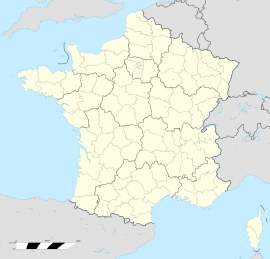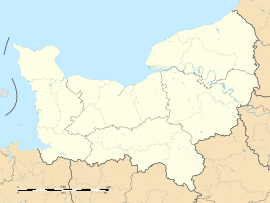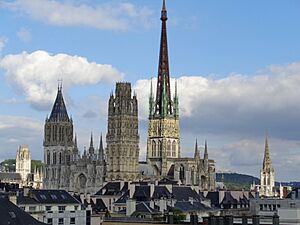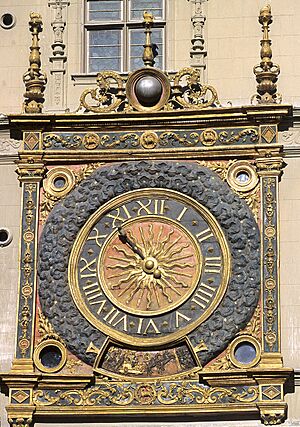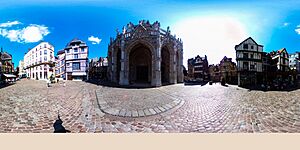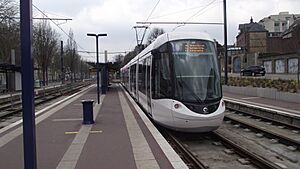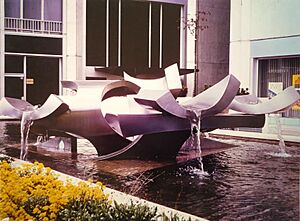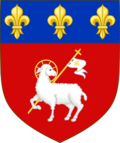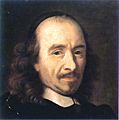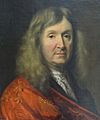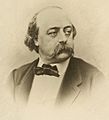Rouen facts for kids
Quick facts for kids
Rouen
|
|||
|---|---|---|---|
|
Prefecture and commune
|
|||
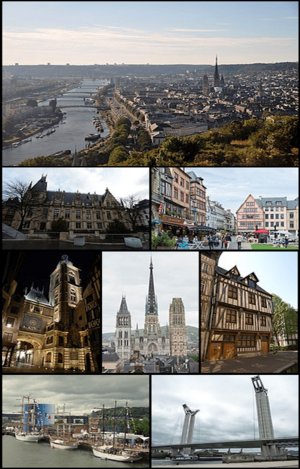
From left to right, top to bottom: partial view of the city and the Seine from Côte Sainte-Catherine; the courthouse; Place du Vieux-Marché; rue du Gros-Horloge, at night; Rouen Cathedral; the National Museum of Education; sailboats during the 2019 edition of the Armada; the Gustave-Flaubert Bridge.
|
|||
|
|||
| Country | France | ||
| Region | Normandy | ||
| Department | Seine-Maritime | ||
| Arrondissement | Rouen | ||
| Canton | 3 cantons | ||
| Intercommunality | Métropole Rouen Normandie | ||
| Area
1
|
21.38 km2 (8.25 sq mi) | ||
| • Urban
(2018)
|
461.1 km2 (178.0 sq mi) | ||
| • Metro
(2018)
|
2,792.2 km2 (1,078.1 sq mi) | ||
| Population
(2021)
|
114,083 | ||
| • Rank | 36th in France | ||
| • Density | 5,336.0/km2 (13,820/sq mi) | ||
| • Urban
(2018)
|
470,369 | ||
| • Urban density | 1,020.10/km2 (2,642.05/sq mi) | ||
| • Metro
(2018)
|
702,945 | ||
| • Metro density | 251.753/km2 (652.038/sq mi) | ||
| Time zone | UTC+01:00 (CET) | ||
| • Summer (DST) | UTC+02:00 (CEST) | ||
| INSEE/Postal code |
76540 /
|
||
| Website | www.rouen.fr | ||
| 1 French Land Register data, which excludes lakes, ponds, glaciers > 1 km2 (0.386 sq mi or 247 acres) and river estuaries. | |||
Rouen is a historic city in northern France. It sits on the Seine River. Rouen is the capital of the Normandy region. It is also the main city of the Seine-Maritime department.
Long ago, Rouen was one of the biggest and richest cities in medieval Europe. Today, about 700,000 people live in its wider area. People from Rouen are called Rouennais.
Rouen was a key city for the Anglo-Normans. These were kings who ruled both England and parts of France from the 11th to 15th centuries. The city grew rich from making textiles and river trade. During the Hundred Years' War, both France and England wanted Rouen. It was here that Joan of Arc was tried and burned at the stake on May 30, 1431.
The city was badly damaged by bombs in 1944 during Operation Overlord. But it quickly rebuilt its economy. Its industries and large seaport helped it recover. In 2021, its port joined with others to form HAROPA Port.
Rouen is known for its long history and beautiful buildings. It is a major cultural center. Famous places include the Museum of Fine Arts and Rouen Cathedral. Every few years, Rouen hosts "L'Armada," a big gathering of sailing ships. This event makes Rouen a special place for the maritime world.
Contents
History of Rouen
Rouen was first built by a Gaulish tribe called the Veliocasses. They named it Ratumacos. The Romans later called it Rotomagus. It was an important city in Roman Gaul. During Roman times, it had an amphitheater and public baths. In the 5th century, it became a center for bishops.
The Normans took over Rouen in 841. From 912, Rouen was the capital of the Duchy of Normandy. The local dukes lived there. Later, William the Conqueror moved his home to Caen. In 1150, Rouen gained the right to govern itself.
In the 12th century, a Jewish school called La Maison Sublime was in Rouen. It was found in 1976 and is now a museum. About 6,000 Jewish people lived in the city then.
On June 24, 1204, King Philip II Augustus of France took Rouen. This made Normandy officially part of the French Kingdom. Philip II built a new castle, the Château Bouvreuil. Rouen's textile industry grew, using wool from England. The city also thrived from trade on the Seine River.
In the 13th and 14th centuries, there were some troubles in the city. In 1291, the mayor was killed. King Philip IV restored order. He took away some of the city's special rights. But he let the people buy them back later. In 1306, the Jewish community was forced to leave Rouen. In 1389, another revolt happened. Rouen lost its special rights again.
During the Hundred Years' War, Rouen surrendered to Henry V of England in 1419. This made Normandy part of the Plantagenet lands again. Joan of Arc supported French rule. She was burned at the stake on May 30, 1431, in Rouen. Most people in the city at that time supported the Duke of Burgundy, an enemy of the French king. The French king, Charles VII, took Rouen back in 1449.
Rouen was a strong Catholic city during the French Wars of Religion. It was under siege for five months in 1591-1592. This was by the Protestant King Henry IV of France and an English army.
The first competitive car race happened from Paris to Rouen in 1894.
During World War II, Rouen was occupied by German forces. The city was heavily damaged during the D-day bombings. Its famous cathedral was almost destroyed by Allied bombs.
Main Sights and Attractions
Rouen is famous for its beautiful buildings and museums.
Rouen Cathedral and Other Churches
The most famous building is Rouen Cathedral. It has a special tower called the Tour de Beurre (butter tower). This tower was paid for by selling special permissions to eat butter during Lent. The cathedral's Gothic front was finished in the 16th century. The artist Claude Monet painted many famous pictures of the cathedral. These paintings show the cathedral at different times of day. Some of them are in the Musée d'Orsay in Paris.
The Gros Horloge is an old astronomical clock. It was built in the 14th century. You can find it on the Gros Horloge street.
Other important churches include the Church of Saint Ouen (from the 12th–15th centuries) and the Gothic Church of St Maclou (15th century). In the center of the Place du Vieux Marché, where Joan of Arc was executed, stands the modern church of St Joan of Arc. This large church looks like an upside-down Viking boat and a fish.
Historic Buildings and Museums
You can also see Rouen Castle. Its main tower is called the tour Jeanne d'Arc. Joan of Arc was brought here in 1431. The Palais de Justice was once a high court for Normandy. Rouen is also known for its many old half-timbered buildings.
Rouen has many museums:
- The Musée des Beaux-Arts de Rouen is an art museum. It has paintings by famous artists like Claude Monet and Géricault.
- The Musée maritime fluvial et portuaire tells the story of Rouen's port and shipping.
- The Musée des antiquités shows art and history from the Bronze Age to the Renaissance.
- The Musée de la céramique has a great collection of faïence and porcelain. Rouen was famous for these from the 16th to 18th centuries.
- The Museum of Natural History was founded in 1834.
- The Musée Le Secq des Tournelles has many different collections of objects.
Parks and Gardens
The Jardin des Plantes de Rouen is a beautiful botanical garden. It dates back to 1840 in its current form. There is also a park and garden at the Champs de Mars.
Climate in Rouen
Rouen has an oceanic climate. This means it has mild temperatures and rain throughout the year.
| Climate data for Rouen (URO), elevation: 151 m (495 ft), 1991–2020 normals, extremes 1968–present | |||||||||||||
|---|---|---|---|---|---|---|---|---|---|---|---|---|---|
| Month | Jan | Feb | Mar | Apr | May | Jun | Jul | Aug | Sep | Oct | Nov | Dec | Year |
| Record high °C (°F) | 15.7 (60.3) |
19.7 (67.5) |
24.4 (75.9) |
27.4 (81.3) |
30.0 (86.0) |
36.0 (96.8) |
41.3 (106.3) |
38.4 (101.1) |
33.0 (91.4) |
28.0 (82.4) |
20.3 (68.5) |
15.6 (60.1) |
41.3 (106.3) |
| Mean maximum °C (°F) | 12.8 (55.0) |
14.1 (57.4) |
18.4 (65.1) |
22.6 (72.7) |
26.0 (78.8) |
29.8 (85.6) |
32.2 (90.0) |
31.7 (89.1) |
27.3 (81.1) |
21.6 (70.9) |
16.3 (61.3) |
13.0 (55.4) |
33.5 (92.3) |
| Mean daily maximum °C (°F) | 6.9 (44.4) |
7.9 (46.2) |
11.4 (52.5) |
14.8 (58.6) |
17.9 (64.2) |
21.1 (70.0) |
23.4 (74.1) |
23.4 (74.1) |
20.1 (68.2) |
15.4 (59.7) |
10.4 (50.7) |
7.3 (45.1) |
15.0 (59.0) |
| Daily mean °C (°F) | 4.3 (39.7) |
4.8 (40.6) |
7.5 (45.5) |
10.0 (50.0) |
13.1 (55.6) |
16.1 (61.0) |
18.2 (64.8) |
18.2 (64.8) |
15.3 (59.5) |
11.7 (53.1) |
7.5 (45.5) |
4.7 (40.5) |
11.0 (51.7) |
| Mean daily minimum °C (°F) | 1.6 (34.9) |
1.6 (34.9) |
3.5 (38.3) |
5.2 (41.4) |
8.3 (46.9) |
11.1 (52.0) |
13.0 (55.4) |
13.1 (55.6) |
10.6 (51.1) |
8.0 (46.4) |
4.6 (40.3) |
2.1 (35.8) |
6.9 (44.4) |
| Mean minimum °C (°F) | −6.0 (21.2) |
−5.3 (22.5) |
−2.4 (27.7) |
−0.6 (30.9) |
2.6 (36.7) |
5.7 (42.3) |
8.1 (46.6) |
7.9 (46.2) |
5.3 (41.5) |
1.4 (34.5) |
2.2 (36.0) |
−4.6 (23.7) |
−7.9 (17.8) |
| Record low °C (°F) | −17.1 (1.2) |
−13.4 (7.9) |
−10.4 (13.3) |
−4.8 (23.4) |
−2.2 (28.0) |
1.1 (34.0) |
5.9 (42.6) |
5.0 (41.0) |
2.1 (35.8) |
−3.2 (26.2) |
−8.3 (17.1) |
−11.3 (11.7) |
−17.1 (1.2) |
| Average precipitation mm (inches) | 75.6 (2.98) |
65.0 (2.56) |
61.6 (2.43) |
55.9 (2.20) |
67.2 (2.65) |
64.3 (2.53) |
64.4 (2.54) |
69.8 (2.75) |
62.1 (2.44) |
79.4 (3.13) |
80.4 (3.17) |
101.8 (4.01) |
847.5 (33.39) |
| Average precipitation days (≥ 1.0 mm) | 13.8 | 11.5 | 10.9 | 10.0 | 10.7 | 9.4 | 9.0 | 9.6 | 9.3 | 12.7 | 13.1 | 14.1 | 134.1 |
| Average relative humidity (%) | 90 | 86 | 83 | 78 | 79 | 80 | 79 | 80 | 84 | 89 | 90 | 91 | 84 |
| Mean monthly sunshine hours | 52 | 77 | 119 | 165 | 182 | 197 | 200 | 190 | 159 | 108 | 58 | 49 | 1,556 |
| Source 1: Meteo France | |||||||||||||
| Source 2: Infoclimat.fr (relative humidity 1961–1990) | |||||||||||||
Getting Around Rouen
Rouen has good transport links.
Train Travel
Main trains run from Gare de Rouen-Rive-Droite to Le Havre and Paris. Regional trains go to Caen, Dieppe, and other places in Normandy. You can also take direct high-speed TGV trains to Lyon and Marseille.
City Transport
Inside Rouen, there is a tram and a bus system. The tramway has two lines that come out of a tunnel under the city center. Buses also run with the tramway.
Air and Sea Travel
Rouen has its own airport. The Seine River is very important for shipping cargo through the Port of Rouen. Ferry ports like Dieppe (50 minutes away) and Calais are also easy to reach by car.
Population of Rouen
| Historical population | ||||||||||||||||||||||||||||||||||||||||||||||||||||||||||||||||||||||||||||||||||||||||||||||||||||||||||||||||||||||
|---|---|---|---|---|---|---|---|---|---|---|---|---|---|---|---|---|---|---|---|---|---|---|---|---|---|---|---|---|---|---|---|---|---|---|---|---|---|---|---|---|---|---|---|---|---|---|---|---|---|---|---|---|---|---|---|---|---|---|---|---|---|---|---|---|---|---|---|---|---|---|---|---|---|---|---|---|---|---|---|---|---|---|---|---|---|---|---|---|---|---|---|---|---|---|---|---|---|---|---|---|---|---|---|---|---|---|---|---|---|---|---|---|---|---|---|---|---|---|
|
|
|||||||||||||||||||||||||||||||||||||||||||||||||||||||||||||||||||||||||||||||||||||||||||||||||||||||||||||||||||||
| Source: EHESS and INSEE (1968-2021) | ||||||||||||||||||||||||||||||||||||||||||||||||||||||||||||||||||||||||||||||||||||||||||||||||||||||||||||||||||||||
Education in Rouen
Rouen has several important schools for higher education. These include the University of Rouen and NEOMA Business School. Both are located near Mont-Saint-Aignan. Other schools are INSA Rouen, ESIGELEC, ESITech, and the CESI. These are located near Saint-Étienne-du-Rouvray.
Culture and Sports
Rouen has a lively cultural scene. The main opera company is the Opéra de Rouen – Normandie. They perform at the Théâtre des Arts. They offer opera, classical music, and dance shows. Every five years, the city hosts a huge maritime event called L'Armada.
Sports Teams
- Football: The city's football team is Quevilly-Rouen. They play in Ligue 2. Their home stadium is the Stade Robert Diochon.
- Rugby: Rouen Normandie Rugby plays in the second-tier Pro D2. They are one of the few professional rugby teams from northern France.
- Ice Hockey: The Dragons de Rouen ice hockey club plays in the top-tier Ligue Magnus. They play at the Île Lacroix arena.
- Baseball: Baseball is also played in Rouen. The local team, Huskies de Rouen, plays in the top French league. They also compete in European games.
Famous People from Rouen
Rouen is the birthplace of many notable people.
- Edward IV (1442–1483), a King of England.
- Pierre Corneille (1606–1684), a famous writer of tragedies.
- René-Robert Cavelier, Sieur de La Salle (1643–1687), a famous explorer.
- Bernard le Bovier de Fontenelle (1657–1757), an author and nephew of Pierre Corneille.
- Théodore Géricault (1791–1824), a well-known painter.
- Gustave Flaubert (1821–1880), a famous novelist.
- Maurice Leblanc (1864–1941), a novelist.
- Marcel Duchamp (1887–1968), a famous artist.
- François Hollande (b. 1954), the 24th President of the French Republic.
- Thomas Pesquet (b. 1978), an astronaut.
- Pierre Gasly (b. 1996), a Formula One race car driver.
International Connections
Rouen is twinned with several cities around the world. This means they have special friendly relationships.
 Baton Rouge, Louisiana, United States, since 1963
Baton Rouge, Louisiana, United States, since 1963 Hannover, Germany, since 1966
Hannover, Germany, since 1966 Norwich, Norfolk, England, United Kingdom, since 1959
Norwich, Norfolk, England, United Kingdom, since 1959 Cleveland, Ohio, United States, since 2008
Cleveland, Ohio, United States, since 2008 Pomeranian Voivodeship, Poland, since 1992
Pomeranian Voivodeship, Poland, since 1992 Salerno, Campania, Italy, since 2002
Salerno, Campania, Italy, since 2002 Zhejiang, China, since 1990
Zhejiang, China, since 1990
Art and Symbols
Sculptures in the City
In the late 20th century, several sculptures by Jean-Yves Lechevallier were placed in Rouen. In 2010, an art project called Rouen Impressionnée featured a sculpture by Belgian artist Arne Quinze. This sculpture, named 'Camille', used wood, concrete, paint, and metal. It was placed on the Boieldieu Bridge to show the historical separation of the city's people.
Rouen in Paintings
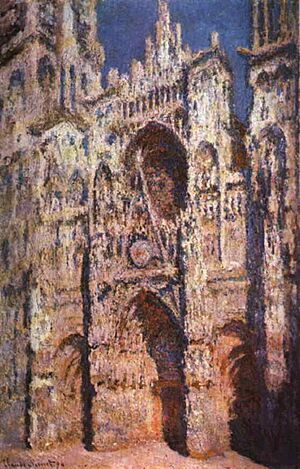
Rouen Cathedral is famous for being the subject of many paintings by the Impressionist artist Claude Monet. He painted the cathedral at different times of day to show how the light changed it. Some of these paintings are in the National Gallery of Art in Washington, D.C., and the Pushkin Museum in Moscow. One painting is in the National Museum of Serbia. These paintings are very valuable.
City Coat of Arms
| The coat of arms of Rouen shows a red background. On it is a white pascal lamb with a halo. The lamb looks back over its shoulder and holds a white flag with a gold cross. Above this, a wide blue band at the top has three gold fleurs de lis.
Long ago, in the 12th century, the official seal of Rouen had a leopard. This was before Normandy became part of France. You can still see this old symbol on the front of the "Grand Poste" building. |
Images for kids
-
A class at the Lycée Pierre-Corneille, Rouen 1902, artists Robert Antoine Pinchon (second row, right) and Marcel Duchamp (third row, left)
See also
 In Spanish: Ruan para niños
In Spanish: Ruan para niños




